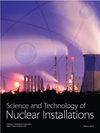Analysis of the Effect of Applied Load on Crevice Corrosion Behavior
IF 1
4区 工程技术
Q3 NUCLEAR SCIENCE & TECHNOLOGY
引用次数: 0
Abstract
A two-dimensional numerical model incorporating solid mechanics, electrochemistry, mass diffusion, and ion migration processes is developed to investigate the load effect on the crevice corrosion. The model is a transient model of crevice corrosion occurring in cracks of 304 stainless steel in a dilute NaCl solution, and the interaction between stress and electrochemical corrosion was considered. By solving the multiphysical coupling model in COMSOL, the effect of applied load on electrochemical corrosion in the crack tip region was calculated, and the local corrosion current density in the crack tip region with stress concentration within the crack was also calculated by using the Tafel relationship. The distribution of Fe2+ ion, Na+ ion, CL− ion, and H and O2 substance concentrations within the crack cavity is predicted by the equation analysis of substance transport. The results show that metal oxidation is more clearly affected by plastic deformation, the rate of hydrogen evolution reaction increases with stress enhancement, and the oxygen absorption reaction is not affected by stress strain. The distribution of iron ions, hydrogen, and oxygen within the crack is affected by the electrochemical reaction rate, and the distribution of iron ions, sodium ions, and chloride ions is affected by the electrolyte potential.外加载荷对缝隙腐蚀行为的影响分析
建立了一个包含固体力学、电化学、质量扩散和离子迁移过程的二维数值模型,以研究载荷对缝隙腐蚀的影响。该模型是304不锈钢裂纹在稀NaCl溶液中发生缝隙腐蚀的瞬态模型,考虑了应力与电化学腐蚀的相互作用。通过求解COMSOL中的多物理耦合模型,计算了外加载荷对裂纹尖端区域电化学腐蚀的影响,并利用Tafel关系计算了裂纹尖端区域局部腐蚀电流密度与裂纹内应力集中的关系。通过物质传输方程分析预测了裂纹腔内Fe2+离子、Na+离子、CL−离子以及H和O2物质浓度的分布。结果表明,塑性变形对金属氧化的影响更明显,析氢反应速率随着应力的增强而增加,吸氧反应不受应力应变的影响。裂纹内铁离子、氢和氧的分布受电化学反应速率的影响,铁离子、钠离子和氯离子的分布受电解质电势的影响。
本文章由计算机程序翻译,如有差异,请以英文原文为准。
求助全文
约1分钟内获得全文
求助全文
来源期刊

Science and Technology of Nuclear Installations
NUCLEAR SCIENCE & TECHNOLOGY-
CiteScore
2.30
自引率
9.10%
发文量
51
审稿时长
4-8 weeks
期刊介绍:
Science and Technology of Nuclear Installations is an international scientific journal that aims to make available knowledge on issues related to the nuclear industry and to promote development in the area of nuclear sciences and technologies. The endeavor associated with the establishment and the growth of the journal is expected to lend support to the renaissance of nuclear technology in the world and especially in those countries where nuclear programs have not yet been developed.
 求助内容:
求助内容: 应助结果提醒方式:
应助结果提醒方式:


